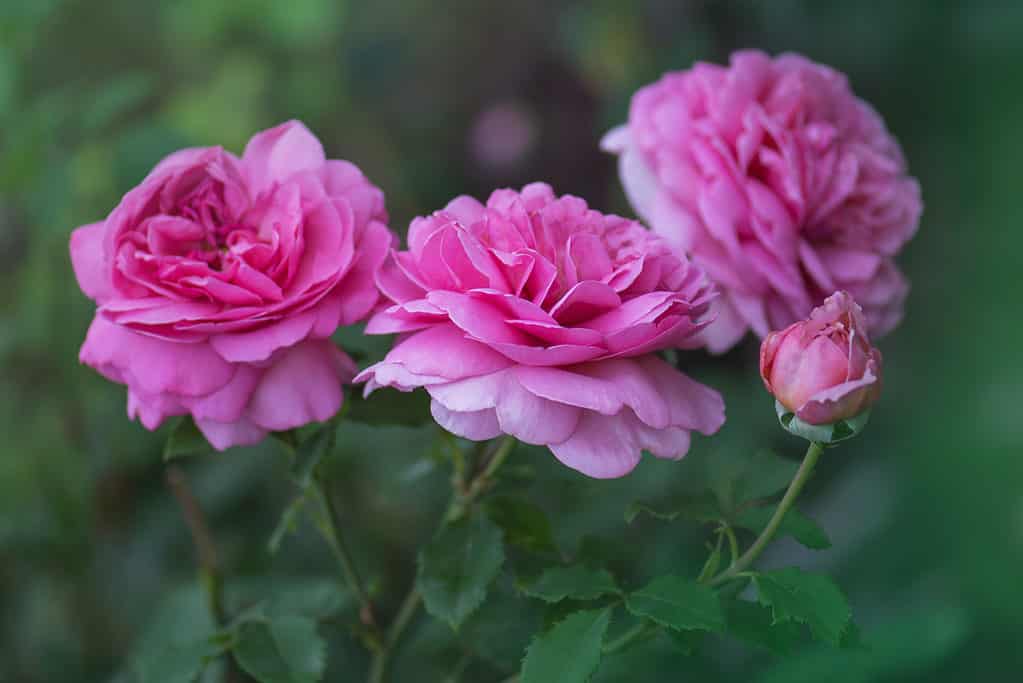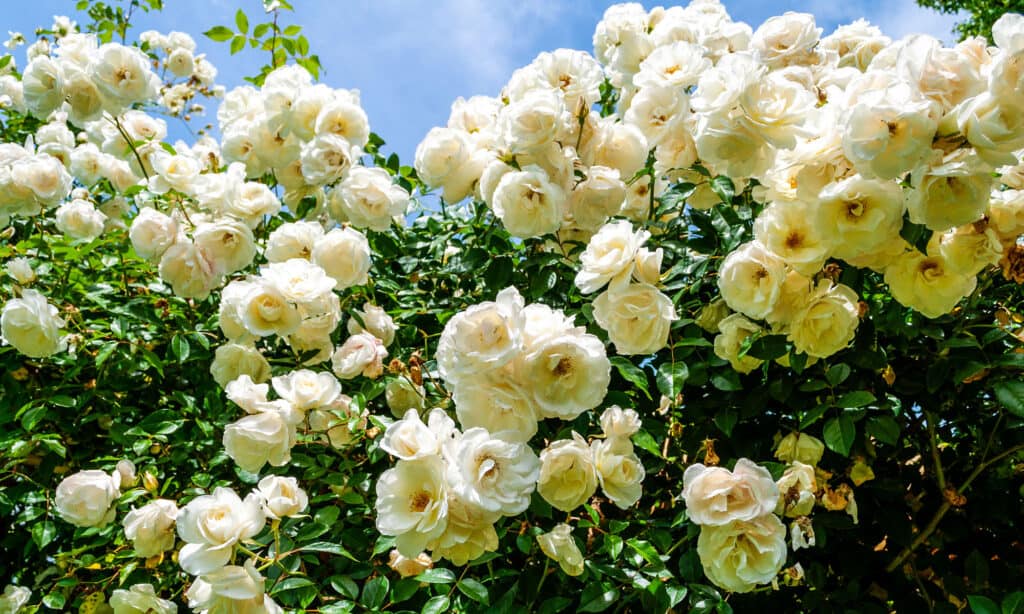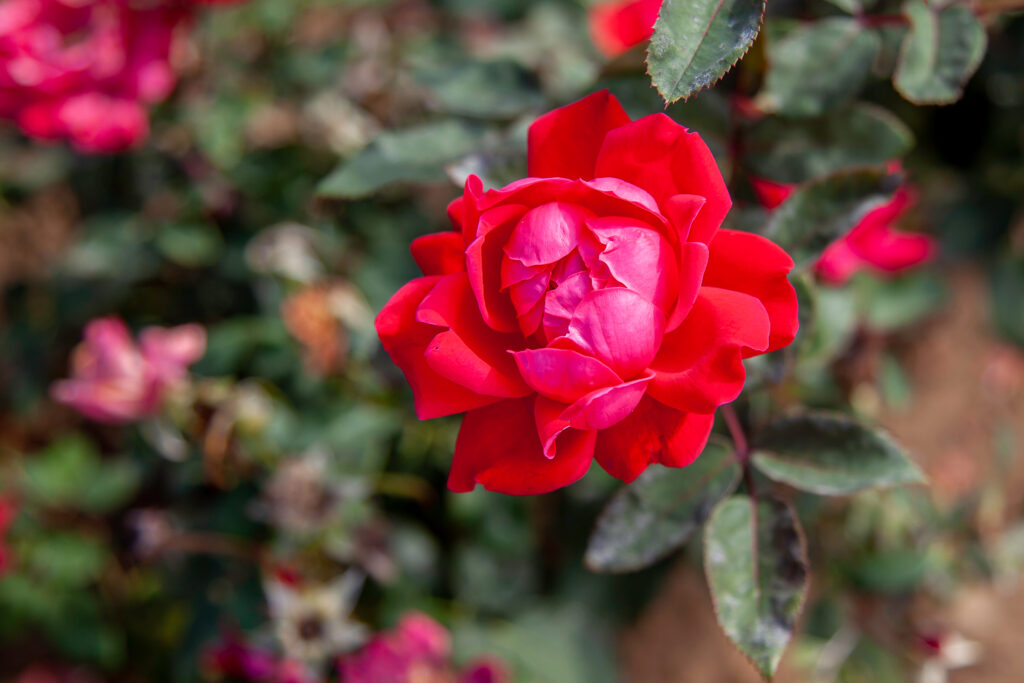If you’re looking for roses that grow in shade, you’re in luck. Roses are typically thought of as full-sun-loving plants and are not typically thought of for shady gardening. However, you might still be able to produce certain kinds if your garden does not exactly receive the six to eight hours of full light that is advised for roses. No rose will grow and blossom without some sunlight, but certain roses can tolerate moderate shadow quite well.
The most floriferous roses, such as floribundas and shrub roses, will typically thrive in shade. Some blossoms will perish if there are fewer than six hours of sunlight each day. However, as long as you choose a rose that blooms profusely and produces large blossoms, your plant will be content with a little less sun.
Even having some roses in the shade might have its benefits. Pale petaled flowers that in direct sunlight might appear washed out will appear to glow in partial shade. So, what do you have to lose? Let’s jump into our list of the best roses that grow in shade!
1. Princess Alexandra of Kent Rose
The Princess Alexandra of Kent rose is a gorgeous and well-known rose variety named in honor of Princess Alexandra, a member of the British royal family. This David Austin-bred rose has a distinctive fusion of traditional grace and contemporary beauty.
A deep, warm pink hue is seen in the big, double blossoms of the Princess Alexandra of Kent rose. The petals are softly cupped and form beautiful rosettes with a wonderful scent. The flowers have long, strong stems that make them perfect for cutting and beautiful floral arrangements.
This rose is renowned for having a robust and healthy growth habit. It grows into a well-rounded shrub with glossy, deep-green leaves that create a lovely backdrop for the lavish blooms. The rose blooms repeatedly, producing an abundance of blossoms from the beginning of summer until the first frost.
The Princess Alexandra of Kent rose can withstand some shade as well as full sun, where it flourishes. For optimum development and a profusion of flowers, it is advised to give the rose at least four to six hours of direct sunshine each day. This rose may, however, still thrive in sites with little sunshine, such as those that are shaded by buildings or trees, though blooming may be significantly diminished.

The Princess Alexandra of Kent rose (pictured) is popular for being a beautiful repeat bloomer.
©LesiChkalll27/Shutterstock.com
2. Carefree Wonder Rose
Popular and highly acclaimed, the Carefree Wonder rose is renowned for its excellent resilience and ease of care. This rose, which Meilland International introduced, has a number of lovely qualities that make it a favorite among gardeners.
The Carefree Wonder rose’s abundance of colorful, double flowers is one of its most distinctive features. The blossoms have a dramatic visual effect because of their alluring combination of pink and white tones. Throughout the flowering season, these blossoms form clusters that cover the shrub completely and provide a magnificent show.
Additionally prized for its great disease resistance, this rose cultivar. It has extraordinary resistance to widespread rose diseases including powdery mildew and black spot, requiring less regular spraying or treatments. This characteristic makes it a great option for people looking for a rose that requires little maintenance yet puts on a spectacular display.
The Carefree Wonder rose is regarded as having very adaptive light needs. Although it prefers full light, it can handle little shade as well. For best development and flowering, it is advised to give the rose at least four to six hours of direct sunshine each day. Although it may yield somewhat fewer blooms than roses grown in full sun, the rose may still grow quite well in locations with moderate shadow.
3. Hansa Rose
Famous for its outstanding beauty and toughness, the Hansa rose is a traditional and well-loved heritage rose. This hybrid Rugosa rose is a prized addition to gardens all around the world because of its hardiness, disease resistance, and gorgeous flowers.
Large, semi-double blooms with vivid hues of magenta, purple, or deep pink are produced by the Hansa rose. Its attraction is increased by the sweet, spiciness of the blooms’ aroma. The rose produces an eye-catching display of color and perfume as it blooms freely throughout the summer.
The Hansa rose’s amazing capacity to endure difficult growth circumstances is one of its best traits. It is a low-maintenance option for gardeners due to its strong resistance to diseases and pests. This rose is also renowned for its ability to withstand extreme weather, such as frigid winters and seaside environments.
The Hansa rose enjoys full sunshine when it comes to light needs. Locations with at least six hours of direct sunshine each day are ideal for it to flourish. It can withstand some shade but will yield fewer flowers. The rose may produce fewer flowers in locations with little sunshine, but it will still grow and flourish.
4. Fair Bianca Rose
The Fair Bianca rose is a beautiful and appealing type that is prized for its snow-white blossoms and alluring scent. This David Austin-bred English rose exhibits a timeless beauty that inspires feelings of romance and grace.
Large, completely double blooms with a classic rosette form are produced by Fair Bianca. The pure white petals give out a delicate and sweet aroma that gives any garden or bouquet a touch of elegance. The blossoms are perfect for cutting and consuming indoors since they are supported by strong, erect stems.
When it comes to growth patterns, Fair Bianca develops into a dense, bushy shrub that grows to a height of around three to four feet. Its glossy, dark green foliage creates a visually appealing contrast with the pure white blossoms by serving as an exquisite backdrop.
While the Fair Bianca rose does best in full light, it can also take little shade. For optimum development and growth of flowers, it is advised to give the rose at least four to six hours of direct sunshine each day. However, in places with dappled shade, early light, and afternoon shadow, this rose variety can still function quite well.
5. Ballerina Rose
The pleasant and adaptable Ballerina rose is renowned for its abundance of petite, delicate blooms and elegant growth habit. Due to its outstanding beauty and adaptability, this lovely shrub rose developed by B. R. Cant & Sons has gained enormous appeal among gardeners.
The Ballerina rose features clusters of tiny, solitary blossoms that are pink in color and are gentle and delicate. These delicate flowers have a delightful simplicity and fill the air with a pleasant aroma. Throughout the summer, the rose blooms profusely, filling any garden with a spectacular display of color and a lively ambiance.
The amazing durability and adaptability of the Ballerina rose is one of its unique traits. It can endure both heat and cold and thrives in a variety of growth environments. Additionally, this rose type has a high level of disease resistance, making it a low-maintenance option for gardeners.
The full sun is preferred by the Ballerina rose when it comes to light needs. Locations with at least six hours of direct sunshine each day are ideal for it to flourish. However, it can also withstand some shade. The rose may still grow and bloom in locations with little sunshine but with slightly less blossoming and possibly smaller flowers. It is essential to remember that the rose may bloom less profusely the more shade it gets.
6. Iceberg Rose
The popular and well-known Iceberg rose is known for its gorgeous clusters of snow-white flowers and robust growth. Since its introduction by Kordes in 1958, this floribunda rose has grown to be one of the most well-liked and commonly cultivated roses in the world. And it’s a great choice for roses that grow in shade.
The abundance of tiny to medium-sized blooms on the Iceberg rose are distinguished by their appearance in massive clusters. The pure white petals are shaped like a traditional rose and have a soft, pleasant scent. This rose’s prolific blossoming produces an amazing show that lasts from spring to fall.
The Iceberg rose’s excellent disease resistance is one of its outstanding traits. It displays impressive resistance to typical rose diseases like powdery mildew and black spot, making it a low-maintenance option for gardeners. Its robust growth pattern and insect resistance are other factors in its appeal.
The Iceberg rose is said to be quite adaptive in terms of sunshine needs. Although it prefers full light, it can take little shade. For the best possible growth and a healthy plant overall, it is advised to give the rose at least four to six hours of direct sunshine each day. The Iceberg rose may still grow quite well in regions with moderate shadow, though (you’re probably seeing a pattern here) it will produce fewer roses.

Iceberg roses (pictured) are known for being hardy and tolerant of drought.
©GAT0/Shutterstock.com
7. Red Knockout Rose
Due to its striking red blooms and outstanding disease resistance, the robust and hardy Red Knockout rose has become quite popular among gardeners and florists. The continual flowering and easy maintenance of this hybrid shrub rose, which William Radler first introduced, have made it a favorite among gardeners.
Large, semi-double blooms in a stunning shade of vivid red may be seen on the Red Knockout rose. Throughout the flowering season, from spring through fall, the clusters of blooms produce a stunning show of color. This rose not only has exceptional beauty but also has good disease resistance.
The Red Knockout rose needs enough sunshine to grow well, and it prefers direct sunlight. For the best development, it likes at least six hours of direct sunshine each day. Even though it can withstand some shade, it’s crucial to remember that less sunshine might have an adverse effect on its general performance and flowering. In comparison to plants grown in full sun, the Red Knockout rose may have a more open growth habit in shady regions. Regardless, they still qualify as roses that grow in shade.

The Red Knockout rose (pictured) is known for its excellent disease resistance.
©JHVEPhoto/Shutterstock.com
8. Anthony Meilland Rose
The intriguing and refined Anthony Meilland rose is renowned for its gorgeous flowers, alluring fragrance, and robust growth. Meilland International’s hybrid tea rose has a timeless beauty that conjures up feelings of romance and grace.
The enormous, high-centered blooms of the Anthony Meilland rose have silky, deep crimson petals. The flowers’ long, robust stems make them perfect for cutting into beautiful floral arrangements. This rose not only has a lovely look, but it also has a wonderful aroma that is sometimes characterized as a blend of citrus and rose fragrances.
The Anthony Meilland rose grows into a well-rounded, bushy shrub that is around four to five feet tall. The glossy, deep green foliage serves as a lovely backdrop for the vivid red blossoms, producing a contrast that is visually appealing.
Although the Anthony Meilland rose prefers full sun, it can tolerate moderate partial shade. It is advised to give this rose at least four to six hours of direct sunshine each day. The rose may, however, still thrive in regions with little sunshine, such as those that are covered by buildings or trees.
9. Mary Rose
This rose is a more classic entry on our list of roses that grow in shade. The Mary rose is a well-known and alluring variety that is praised for its traditional appeal and beautiful look. David Austin created this English shrub rose that honors the Tudor era and bears the name Mary in honor of Henry VIII’s flagship.
Large, cup-shaped blooms with petals that range in hue from delicate pink to a darker shade of rose characterize the Mary rose. A wonderful scent with notes of fruity and myrrh is abundantly present in the blossoms. The rose is a favorite among gardeners and rose fans because of its gorgeous look and alluring perfume.
The Mary rose develops into a well-rounded, bushy shrub as it grows. The numerous and repeat-flowering blossoms are elegantly framed by the plant’s rich, green leaves. It has a great reputation for disease resistance, and gardeners often choose this rose type since it requires less maintenance.
The Mary rose can take a little shade, but it loves full sun. For the most possible flowering, it is advised to give the rose at least four to six hours of direct sunshine each day. The rose may, however, nevertheless survive in dimly lit places, such as those that are shaded by buildings or trees.
10. Playboy Rose
A rarer entry in our list of roses that grow in shade, the Playboy rose is adored for its vivid red blossoms and commanding presence. It is a seductive and flamboyant type of rose, hence its name. With its alluring beauty and potent aroma, Warriner’s 1976 introduction of this hybrid tea rose has captured the attention of gardeners for decades now.
The Playboy rose features enormous, completely double blossoms in an alluring deep red color. The velvety petals are shaped like a traditional rose and feature a strong, enticing aroma that adds to their attractiveness. The flowers are supported by robust, lengthy stems, which make them perfect for cutting and dramatic floral arrangements.
The Playboy rose grows in a tall, upright shrub that may grow to a height of around four to five feet. Its glossy, deep green foliage makes for an eye-catching backdrop for the vivid red blossoms, which contrast sharply.
The full sun is ideal for the Playboy rose in terms of light needs. It needs at least six hours of direct sunshine each day in order to develop and blossom at its best. It’s vital to remember that while it may withstand some shade, less sunshine might have an adverse effect on its overall performance and flowering. However, it can handle shadier areas when compared to similar roses.
The photo featured at the top of this post is © Nagel Photography/Shutterstock.com
Thank you for reading! Have some feedback for us? Contact the AZ Animals editorial team.






